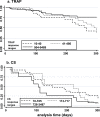Correlation of memory T cell responses against TRAP with protection from clinical malaria, and CD4 CD25 high T cells with susceptibility in Kenyans
- PMID: 18446217
- PMCID: PMC2323567
- DOI: 10.1371/journal.pone.0002027
Correlation of memory T cell responses against TRAP with protection from clinical malaria, and CD4 CD25 high T cells with susceptibility in Kenyans
Erratum in
- PLoS One. 2011;6(2). doi: 10.1371/annotation/23d1eb6a-45de-4181-a6dd-eff9b08d2669
Abstract
Background: Immunity to malaria develops naturally in endemic regions, but the protective immune mechanisms are poorly understood. Many vaccination strategies aim to induce T cells against diverse pre-erythrocytic antigens, but correlates of protection in the field have been limited. The objective of this study was to investigate cell-mediated immune correlates of protection in natural malaria. Memory T cells reactive against thrombospondin-related adhesive protein (TRAP) and circumsporozoite (CS) protein, major vaccine candidate antigens, were measured, as were frequencies of CD4(+) CD25(high) T cells, which may suppress immunity, and CD56(+) NK cells and gammadelta T cells, which may be effectors or may modulate immunity.
Methodology and principal findings: 112 healthy volunteers living in rural Kenya were entered in the study. Memory T cells reactive against TRAP and CS were measured using a cultured IFNgamma ELISPOT approach, whilst CD4(+) CD25(high) T cells, CD56(+) NK cells, and gammadelta T cells were measured by flow cytometry. We found that T cell responses against TRAP were established early in life (<5 years) in contrast to CS, and cultured ELISPOT memory T cell responses did not correlate with ex-vivo IFNgamma ELISPOT effector responses. Data was examined for associations with risk of clinical malaria for a period of 300 days. Multivariate logistic analysis incorporating age and CS response showed that cultured memory T cell responses against TRAP were associated with a significantly reduced incidence of malaria (p = 0.028). This was not seen for CS responses. Higher numbers of CD4(+) CD25(high) T cells, potentially regulatory T cells, were associated with a significantly increased risk of clinical malaria (p = 0.039).
Conclusions: These data demonstrate a role for central memory T cells in natural malarial immunity and support current vaccination strategies aimed at inducing durable protective T cell responses against the TRAP antigen. They also suggest that CD4(+) CD25(high) T cells may negatively affect naturally acquired malarial immunity.
Conflict of interest statement
Figures





References
-
- Roetynck S, Baratin M, Johansson S, Lemmers C, Vivier E, et al. Natural killer cells and malaria. Immunol Rev. 2006;214:251–63. - PubMed
-
- Sakaguchi S. Naturally arising Foxp3-expressing CD25+CD4+ regulatory T cells in immunological tolerance to self and non-self. Nat Immunol. 2005;6:345–52. - PubMed
-
- Hisaeda H, Maekawa Y, Iwakawa D, Okada H, Himeno K, et al. Escape of malaria parasites from host immunity requires CD4+ CD25+ regulatory T cells. Nat Med. 2004;10:29–30. - PubMed
-
- Walther M, Tongren JE, Andrews L, Korbel D, King E, et al. Upregulation of TGF-beta, FOXP3, and CD4+CD25+ regulatory T cells correlates with more rapid parasite growth in human malaria infection. Immunity. 2005;23:287–96. - PubMed
Publication types
MeSH terms
Substances
Grants and funding
LinkOut - more resources
Full Text Sources
Other Literature Sources
Medical
Research Materials

